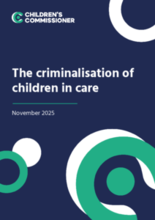Displaying 1 - 10 of 1172
Whether we always know it or not, Artificial Intelligence (AI) is a now an element of many of the digital and electronic tools many of us use every day in our professional and personal lives.
This article describes how thousands of adults who grew up in the UK care system continue to struggle to access their childhood care records — files that often hold the only written account of their early lives and decisions made about them.
The BBC investigation reveals that more than 1,000 adopted children in the UK have returned to care in the past five years, exposing a hidden crisis in which adoptive parents struggling to support traumatised children face blame, threats, and inad
This article reports how an investigation reveals that in 2024, over 2,000 children, including 864 trafficked children (37%) and 1,501 unaccompanied asylum-seeking children (13%), disappeared from care under UK local authorities, exposing alarming
This article reports that in 2024, over 2,000 children identified as trafficked or unaccompanied asylum seekers went missing while under the care of local authorities in the UK — 37% of 2,335 trafficked children, and 13% of 11,999 lone‑child asyl
This article notes how the UK government has announced a review of the National Protocol aimed at reducing the unnecessary criminalisation of children in care and care leavers, responding to evidence that they are disproportionately cautioned or c
This article reports that Alf Dubs, a veteran Labour peer and former child refugee, strongly criticized the new asylum proposals by the Home Office under Shabana Mahmood, accusing the government of “using children as a weapon.” The proposed reform
This Guardian article tells the story of Craig, who became homeless at 13 after running away from a children’s home in Nottingham.
The Family Network Pilot (FNP) aims to help UK children stay safely within their extended families and prevent entry into care by providing Family Group Conferences and Family Network Support Packages. This report evaluates the pilot’s implementation, processes, and impacts across seven local authorities, using qualitative research and monitoring data analysis.
The Children’s Commissioner’s report “The Criminalisation of Children in Care” reveals a deeply concerning pattern: children in care in the UK are disproportionately drawn into the criminal justice system, often for low-level incidents that, in a family setting, would be handled without police involvement. To address this, the Commissioner calls for a strengthened, statutory protocol among police, local authorities, and youth services; better diversion pathways; a more child-friendly prosecution process; increased legal aid and training; more stable, high-quality care placements; and improved data sharing to monitor and prevent harmful police involvement.


